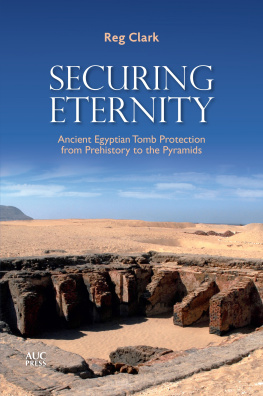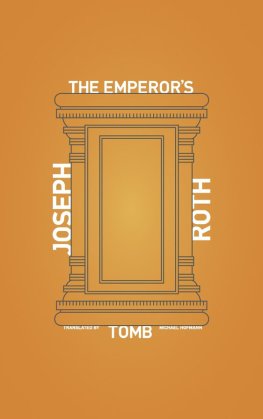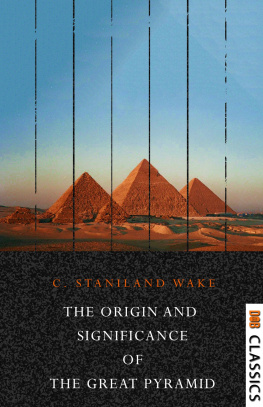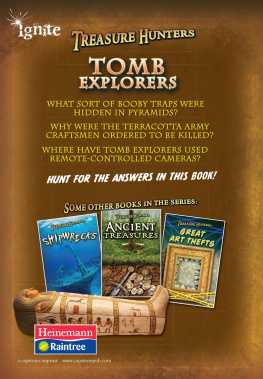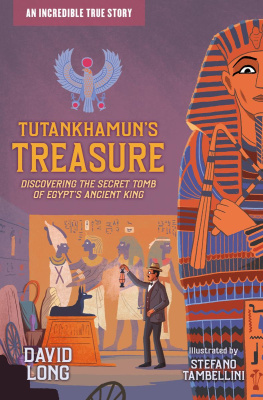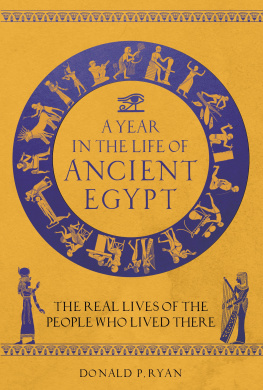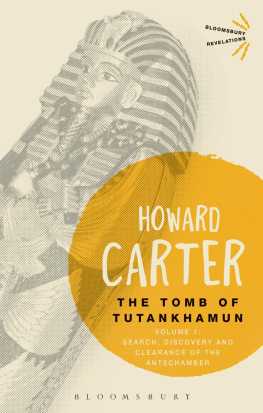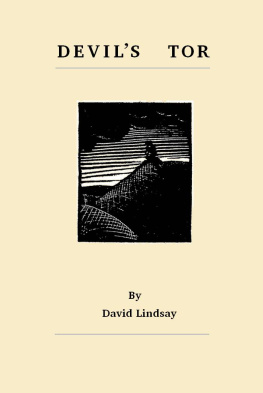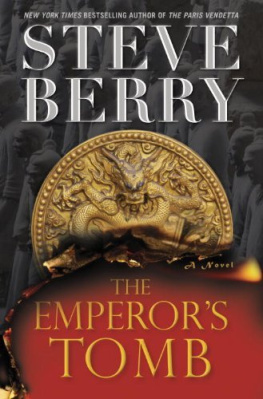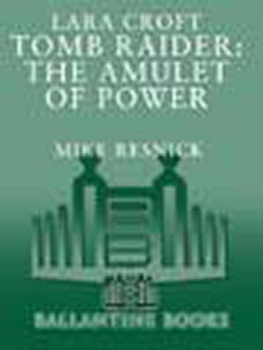SECURITY
ETERNITY
SECURING
ETERNITY
Ancient Egyptian Tomb Protection
from Prehistory to the Pyramids
Reg Clark
The American University in Cairo Press
Cairo New York
This electronic edition published in 2019
The American University in Cairo Press
113 Sharia Kasr el Aini, Cairo, Egypt
420 Fifth Avenue, New York, NY 10018
www.aucpress.com
Copyright 2019 by Reg Clark
All rights reserved. No part of this publication may be reproduced, stored in a retrieval system, or transmitted in any form or by any means, electronic, mechanical, photocopying, recording, or otherwise, without the prior written permission of the publisher.
ISBN 978 977 416 902 1
eISBN 978 1 61797 948 4
Version 1
But with regard to any man who shall do anything evil to my tomb,
or who shall enter it with the intention of stealing,
I shall seize his neck like a birds, and I shall be judged with him in
the court of the Great God....
Inscription from the private tomb of Herymeru at Saqqara
Contents
Maps
1. Map of Egypt, drawn by the author after Bard (2007, map 5.4).
2. Map of Lower Nubia, drawn by the author after Bard (2007, map 5.2).
Figures
1. Stone slabs over the graves at Site 117 at Jebel Sahaba, drawn by the author after Wendorf (1968, fig. 4).
2. A shallow pit burial at Merimde (Junker 1929, plate IIa), courtesy of the sterreichische Akademie der Wissenschaften.
3. Assorted Badarian graves (Brunton and Caton-Thompson 1928, plate 9).
4. Burial at al-Omari Cemetery F (Debono and Mortensen 1990, plate 42.1, fig. 5), courtesy of the German Archaeological Institute (DAI) Cairo.
5. Burial with grave goods at Maadi (Rizkana and Seeher 1990, plate 3), courtesy of the DAI Cairo.
6. Rectangular-shaped graves from Naqada (Petrie and Quibell 1896, plate 83).
7. Typical section through a late Naqada II grave, drawn by the author.
8. Plan of tomb 23 at Cemetery HK6 at Hierakonpolis (Friedman 2005, 4), courtesy of the Hierakonpolis Expedition.
9. Tomb 26 at Cemetery HK6 at Hierakonpolis (Friedman 2008b, fig. 11), courtesy of the Hierakonpolis Expedition.
10. Tomb U-j at Umm al-Qab (Dreyer 1998, plate 3b), courtesy of the DAI Cairo.
11. Grave 85 at al-Kab, adapted by the author from Hendrickx and van Rossum (1994, plates 63 and 64).
12. Tomb 6 in Cemetery 137 at Seyala (Firth 1927, 211).
13. Tomb L23 at Qustul (Williams 1986, fig. 159), courtesy of the Oriental Institute of the University of Chicago.
14. Burial 8 at Kom al-Ahmar (de Morgan 1909, fig. 130).
15. Photograph of tomb 2 at Locality HK6 at Hierakonpolis (Adams 2000, plate 6a), courtesy of British Archaeological Reports.
16. Grave 1845 at Tarkhan (Petrie 1914, plate 12).
17. Tomb B0/1/2, the tomb of King Iry-Hor (Kaiser and Dreyer 1982, fig. 12 and plate 55A), courtesy of the DAI Cairo.
18. Tomb B7/9, the tomb of King Ka (Kaiser and Dreyer 1982, fig. 12 and plate 56B), courtesy of the DAI Cairo.
19. Tomb B17/18, the tomb of King Narmer (Kaiser and Dreyer 1982, fig. 12 and plate 56C), courtesy of the DAI Cairo.
20. Tomb B10/15/19, the tomb of King Hor-Aha (Kaiser and Dreyer 1982, fig. 12 and plate 56C), courtesy of the DAI Cairo.
21. The tomb of King Djer at Umm al-Qab (Kaiser and Dreyer 1982, fig. 12), courtesy of the DAI Cairo. Photograph by the author.
22. The tomb of King Djet at Umm al-Qab (Kaiser and Dreyer 1982, fig. 12; Dreyer 1991, fig. 7), courtesy of the DAI Cairo.
23. The tomb of Queen Merneith at Umm al-Qab and a general view of Umm al-Qab looking southwest toward the wadi (Kaiser and Dreyer 1982, fig. 12), courtesy of the DAI Cairo. Photograph by the author.
24. Grave 63 at Tell al-Farkha (D bowska-Ludwin 2011b, fig. 3).
25. Tomb 1 at Tell Ibrahim Awad (Haarlem 1996, fig. 1).
26. Mastaba V at Nazlet Batran (Daressy 1905, fig. 1; Petrie 1907, fig. 6).
27. Mastaba XVII at Abu Ghurab (Radwan 2000, fig. 2).
28. Tomb S 3357 (Hor-Aha) at Saqqara (Emery 1939, plate 1).
29. Tomb S 3471 at Saqqara (Emery 1949, plate 2).
30. Tomb S 2185 at Saqqara (Quibell 1923, plates 5 and 6.2).
31. Tomb S 3504 at Saqqara (Emery 1954, plates 1 and 3), courtesy of the Egypt Exploration Society.
32. Tomb S 3503 at Saqqara (Emery 1954, plate 38), courtesy of the Egypt Exploration Society.
33. Tomb 68.H.4 at Helwan, drawn by the author after Saad (1951, plan 5).
34. Mastaba 1060 at Tarkhan (Petrie et al. 1913, plates 16.1 and 18).
35. Tomb II at Awlad al-Sheikh (Ranke 1926, figs. 34), courtesy of Walter de Gruyter.
36. Tombs N 1506 and N 1532 at Naga al-Deir (Reisner 1908, fig. 53 and plate 77, plan 2).
37. Tomb IV at Abydos (Hussein 2011, fig. 9).
38. The Naqada Royal Tomb after Borchardt (1898, plate 14).
39. Tombs 1207 and 1208 at Armant (Mond and Myers 1937, plate 5), courtesy of the Egypt Exploration Society.
40. The tomb of King Den at Umm al-Qab (Dreyer et al. 1998, plate 9a; Dreyer 2003b, 69), courtesy of the DAI Cairo.
41. The tomb of King Adjib (Petrie 1900, plate 15; Kaiser and Dreyer 1982, fig. 12), courtesy of the DAI Cairo.
42. The tomb of King Semerkhet (Dreyer 2005, fig. 19; Dreyer et al. 2006, fig. 7), courtesy of the DAI Cairo.
43. The tomb of King Qaa (Kaiser and Dreyer 1982, fig. 12; Dreyer et al. 1996, plate 10a), courtesy of the DAI Cairo.
44. Tomb 2897 at Minshat Abu Omar (Kroeper 1992, fig. 12).
45. Graves 50 and 55 at Tell al-Farkha (D bowska-Ludwin 2009, plate 3; 2012, fig. 17).
46. Tomb MO25 at Cemetery M in Abu Rawash (Klasens 1961, fig. 2), courtesy of the Rijksmuseum van Oudheden.
47. Tombs MO1 and MO2 in Cemetery M at Abu Rawash, drawn by the author after Montet (1938, plate 2).
48. Tomb MO10 in Cemetery M and locking mechanisms, drawn by the author after Montet (1938, 5152 and plate 6).
49. Tomb 1056 at Tura al-Asmant, drawn by the author after Yacoub (1981, plate 17).
50. Tomb 130 at Tura al-Asmant, drawn by the author after Yacoub (1981, plate 18).
51. Tomb 249 at Tura al-Asmant, drawn by the author after El-Khouli (1968, plate 5).
52. Tomb S 3507 at Saqqara and its hidden mound (Emery 1958, plates 85 and 86), courtesy of the Egypt Exploration Society.
53. Tomb S 3506 at Saqqara and axionometric view (Emery 1958, plates 40 and 43), courtesy of the Egypt Exploration Society.
54. Tomb S 3035 (Hemaka) at Saqqara (Emery 1938, plates 1 and 2).
55. Tomb S 3036 (Ankha) at Saqqara (Emery 1949, plates 14 and 15).
56. Tomb X at Saqqara (Emery 1949, plate 43).
57. Tomb S 3338 at Saqqara (Emery 1949, plate 55).
58. Tomb S 3500 at Saqqara (Emery 1958, plate 114), courtesy of the Egypt Exploration Society.
59. The twin portcullises of tomb S 3500 at Saqqara (Emery 1958, plate 119b), courtesy of the Egypt Exploration Society.
60. Tomb S 3505 (Merka) at Saqqara (Emery 1958, plates 24), courtesy of the Egypt Exploration Society.
61. Tomb S 2105 at Saqqara and a view of its portcullis (Quibell 1923, plate 16.2; Reisner 1936, fig. 52).
62. Tomb S 3121 at Saqqara (Emery 1949, plate 48).
63. Tomb S 3120 at Saqqara (Emery 1949, plate 53).
64. Tomb 423.H.9 at Helwan (Saad 1969, plate 13). 1969 University of Oklahoma Press. Reproduced with permission. All rights reserved.
65. Interior of tomb 1390.H.2 at Helwan (Saad 1969, plate 16). 1969 University of Oklahoma Press. Reproduced with permission. All rights reserved.
66. Tomb 1.H.4 at Helwan, drawn by the author after Saad (1951, plan 3).
67. Tomb 150.H.5 at Helwan, drawn by the author after Saad (1951, plan 15).

